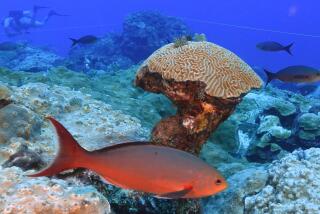Swimming With Dolphins Makes Splash : But Some Environmental Activists Fear Animals Will Be Abused
- Share via
GRASSY KEY, Fla. — The chance to swim with a pod of dolphins and even hop a ride on a passing dorsal fin has tourists lining up at attractions in the Florida Keys, but some environmental activists worry the animals will be exploited.
Three attractions and a resort in the Keys charge as much as $50 each to tourists who have been on waiting lists for more than a month to take their 15-minute “dolphin encounter.”
“Where else are you able to get up close and feel the dolphin’s skin and experience its gentleness and the way it uses its echo-location systems?” said Mike Wood, curator of Theater of the Sea ocean park in Islamorada. “People leave here with a whole new appreciation for these animals. It’s a tremendous educational experience.”
12 Swimmers Every Day
Stormy and Genie, the attraction’s two 7-foot Atlantic bottlenose dolphins, have splashed along with 12 swimmers every day for the last year. They appear to relish the human contact--nuzzling kisses on the cheeks of young women, wagging their powerful tails to stand in the water and “dance,” and even flying out of the water to turn somersaults above swimmers’ heads.
The dolphins chirp and click after each task until the trainer has rewarded them with fish. The wide-eyed tourists come away with spectacular photographs and a few minutes they’ll never forget.
“This is something I’ve wanted to do my whole life and now I can say I’ve done it,” Alan Larosee of North Providence, R.I., said as he climbed out of the oceanside, landlocked lagoon.
But the environmental group Greenpeace is not as enthusiastic.
It views any public display of dolphins for profit as exploitative and is calling for government regulation of swim programs.
Fear of More Programs
“The dolphin swims in the Keys have been very popular and that’s been encouraging several big resorts around the country to think about capturing dolphins for a program of their own,” said Lesley Scheele of the Ft. Lauderdale chapter of Greenpeace.
“Our concern is that this could escalate to the point where everybody trying to lure a tourist is applying to capture dolphins for a swim program,” she said. “This could end up putting a major strain on wild populations.”
Dolphins have been a protected species since 1972 under the Marine Mammal Protection Act, which allows for the tightly controlled capture of dolphins for public display.
But the law does not specifically address “dolphin encounters” or how they should be operated.
“I’ve seen some places where they dump 10 people in the water and they’re all grabbing at one dolphin--all the animal wants to do is get away,” said Chip Hershaw, a trainer at the nonprofit Dolphin Research Center on Grassy Key, which has operated a swim program for three years.
“There’s a right way and a wrong way to go about it,” he said.
Four Swim Programs
Theater of the Sea on Upper Matecumbe Key, Dolphin Research Center and Dolphins Plus in Key Largo are the only places that have been granted federal display permits along with special experimental permits to run the swim programs, whereas Hawk’s Cay Resort operates dolphin swims with only a display permit, said Brian Gorman, a spokesman for the National Marine Fisheries Service in Washington.
The regulatory agency has conducted public hearings on the issue here and in Washington and has appointed an expert panel to come up with a set of dolphin encounter guidelines, Gorman said.
Until those rules are issued, which is expected by midsummer, the fisheries service has ordered a moratorium on any more dolphin swim programs. That has delayed plans by a Hyatt Hotel in Hawaii to capture six dolphins for swims with guests, Gorman said.
“Ideally, we’d like to see the dolphin swims restricted to only nonprofit research facilities, places where there’s a real educational mission,” Scheele said. “Anytime profit is the main motive there’s a possibility of abuse.”
Free Run for Dolphins Urged
The group has also recommended that any swim facility be set up to allow dolphins to come and go from the wild freely and not be forced to interact with humans, said Bo Bricklemyer, a Greenpeace attorney in Washington.
There may also be health risks when humans swim with dolphins, Scheele said, since it is not known exactly what is causing a virus that has killed hundreds of dolphins in the last year along the East Coast. She said there has been no proof that dolphins and humans have exchanged such viruses.
Wood of Theater of the Sea agrees that there should be some regulation, but he believes that many checks are already in place to protect dolphins and said that for-profit attractions can help in that effort.
More to Read
Sign up for The Wild
We’ll help you find the best places to hike, bike and run, as well as the perfect silent spots for meditation and yoga.
You may occasionally receive promotional content from the Los Angeles Times.






